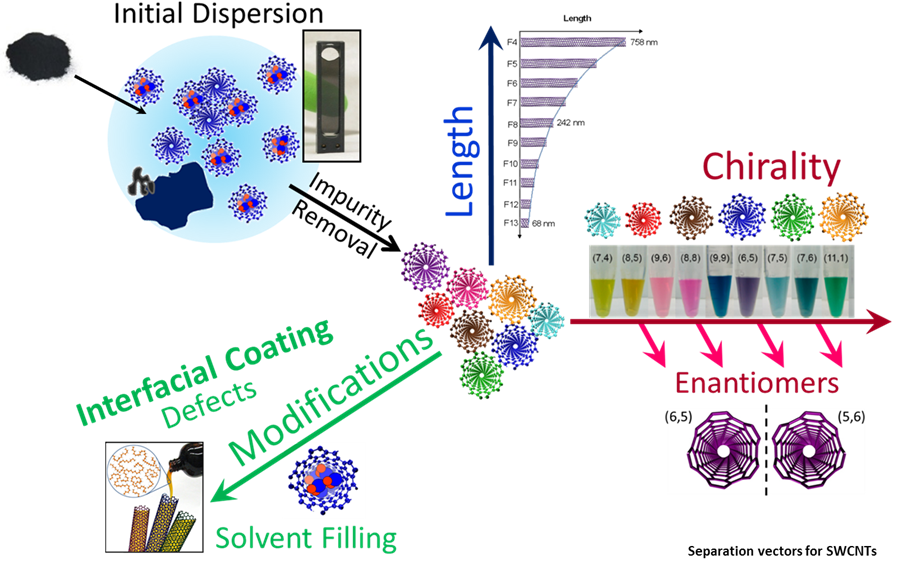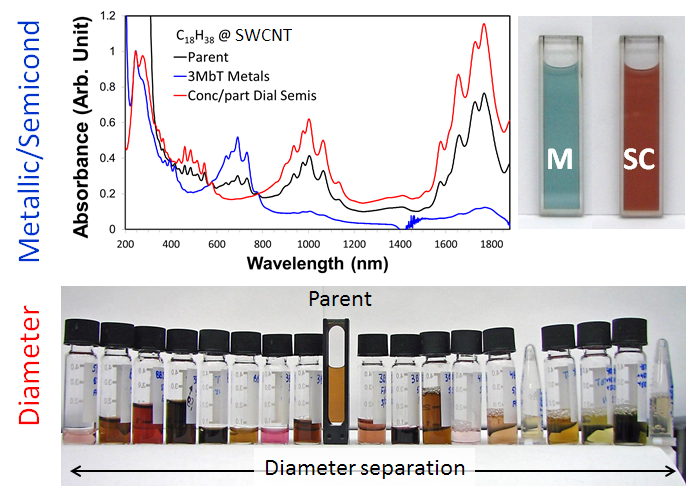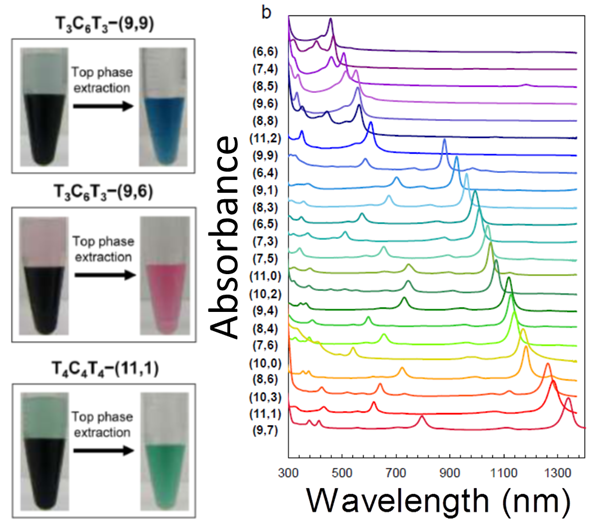Summary
The goal of the Particles, Tubes and Colloids (PTC) project is to develop measurement methods and technologies to enable and improve commerce of dispersed objects such as nanoparticles, colloids and biomolecules. Focus efforts involve improving characterization methods for quantifying nanoparticle characteristics such as size distributions or adsorbed interfacial structures, invention and development of methods for separating carbon nanotubes, and supporting technologies assembled from such materials. We drive these efforts with experimental, theoretical and computational developments, and in directions responsive to the needs of industry and commerce. In addition to publications, this project supports also supports both documentary and physical standards through interaction with international bodies such as VAMAS and ISO, and through the development of NIST RM and SRM materials.
The largest focus of effort within the PTC project is on technology and metrology development involving single-wall carbon nanotubes (SWCNTs). This class of material provides both an ideal model nanoparticle for developing metrology, and has exemplary optical, electrical and mechanical properties for emerging applications. Unfortunately, SWCNTs have only been produced to date as mixtures of many different specific structures, each with its own properties, and contaminants. Through a strategy of separations development and refinement we have pushed the boundaries of SWCNT technology to enable isolation of sub-populations with selected attributes including length, structure (i.e. species or “chirality”), enantiomeric handedness, and purity. Figure 1 diagrams the multiple separation vectors along which and initial polydisperse material (upper left) can be separated through liquid-phase processing to yield pure components.

Well-defined sub-populations of SWCNTs, or other nanoparticles and colloids, allow for clear determination of intrinsic material properties, application development, and systematic approaches for improving measurement methods. Recent highlights include the separation and measurement of the optical activity of many small diameter SWCNT enantiomers, including both metallic and semiconducting species, the demonstration of optical property modulation in SWCNTs through controlled endohedral filling, and characterization of the intrinsic relative Raman scattering cross-sections for multiple resonant SWCNT structures.
In addition to SWCNTs, dispersed systems of 2D materials, polymers, quantum dots, magic number nanoparticles, DNA assemblies, and similar topics are of interest to the project. These topics often focus on developing the metrology necessary to underpin technologies based on emerging science.
We collaborate with other national laboratories, academics, and industry partners. Overall, our results are used to produce research publications, develop documentary standards on how to measure important characteristics, and enable new products to be made using nanotechnology. Selected highlights of project outputs are described in detail below, as are exciting postdoctoral research opportunities available through National Research Council Fellowships. Please contact a project member for more details.
Description
Description
A highlight of the PTC project is our success in purification of well-defined SWCNT populations using liquid phase separation methods. Although we use multiple techniques and methods, ion exchange chromatography, rate-zonal and isopycnic ultracentrifugation, size exclusion chromatography, our primary current method is aqueous two-phase extraction (ATPE). This technique was invented within the PTC project for the separation of SWCNTs, and with it we can rapidly sort many SWCNT populations by metallicity, diameter, species (i.e. (n,m) index), and even enantiomeric handedness (i.e. right-handed or left handed twist). Licensing opportunities for this technology can be discussed through the NIST Technology Transfer Office.
ATPE utilizes the phenomena of spontaneous phase separation above a critical concentration line for pairs of water soluble polymers (or polymer-salt mixtures) to generate spatial separation of dispersed solutes with differing chemical affinities for the two split phases. Advantages of ATPE are that it is rapid, scalable, utilizes dispersants that enable high concentration processing, and is exquisitely tunable. There are two primary versions of the ATPE method. In one version multiple types of surfactants are competed against each other to control the partitioning of the SWCNTs within the two-phase system. In the second version, short oligomers of specified sequence DNA are used to disperse the SWCNTs, with certain combinations of DNA and SWCNT (n,m) structure forming “recognition” hybrids with significantly distinct solvation energies compared to all other hybrids.
Separation of SWCNTs by controlling the nature and amounts of competing surfactants allows for the isolation of metallic from semiconducting nanotubes (including double-wall nanotubes) as well as fractionation by nanotube diameter. Results of both types of separations are shown in Figure 2. Fractionation by these vectors are often critical for technology development. For instance, CNT digital logic applications require high purity populations of solely semiconducting SWCNTs, and sensing applications benefit from spectral response dominated by a single component of known response.

Separation of the SWCNT structures via DNA-ATPE enables direct isolation of specific (n,m) structures, often in a single step, specified even to which enantiomer of the structure (left or right-handed) is purified. This method typically results in extremely pure materials in which contaminant structures are absent, providing high quality samples for intrinsic characterization. The interface of DNA with the SWCNT structure also provides benefits for various technical applications, and is interesting for future systematic control of the nanotube-solution interface.

The SWCNT populations produced in this project have and are being utilized in multiple developmental technologies and for characterization of intrinsic material properties beyond the capacity to list in this space. See the publications list below for details. Efforts in these areas and involving other separation and characterization methods are ongoing.
Major Accomplishments
- See publication list for > 80 reports of characterization methods for dispersed particles, technology developments, and intrinsic properties of SWCNT.
- Invention and licensing of APTE SWCNT technologies
- World first SWCNT reference materials

